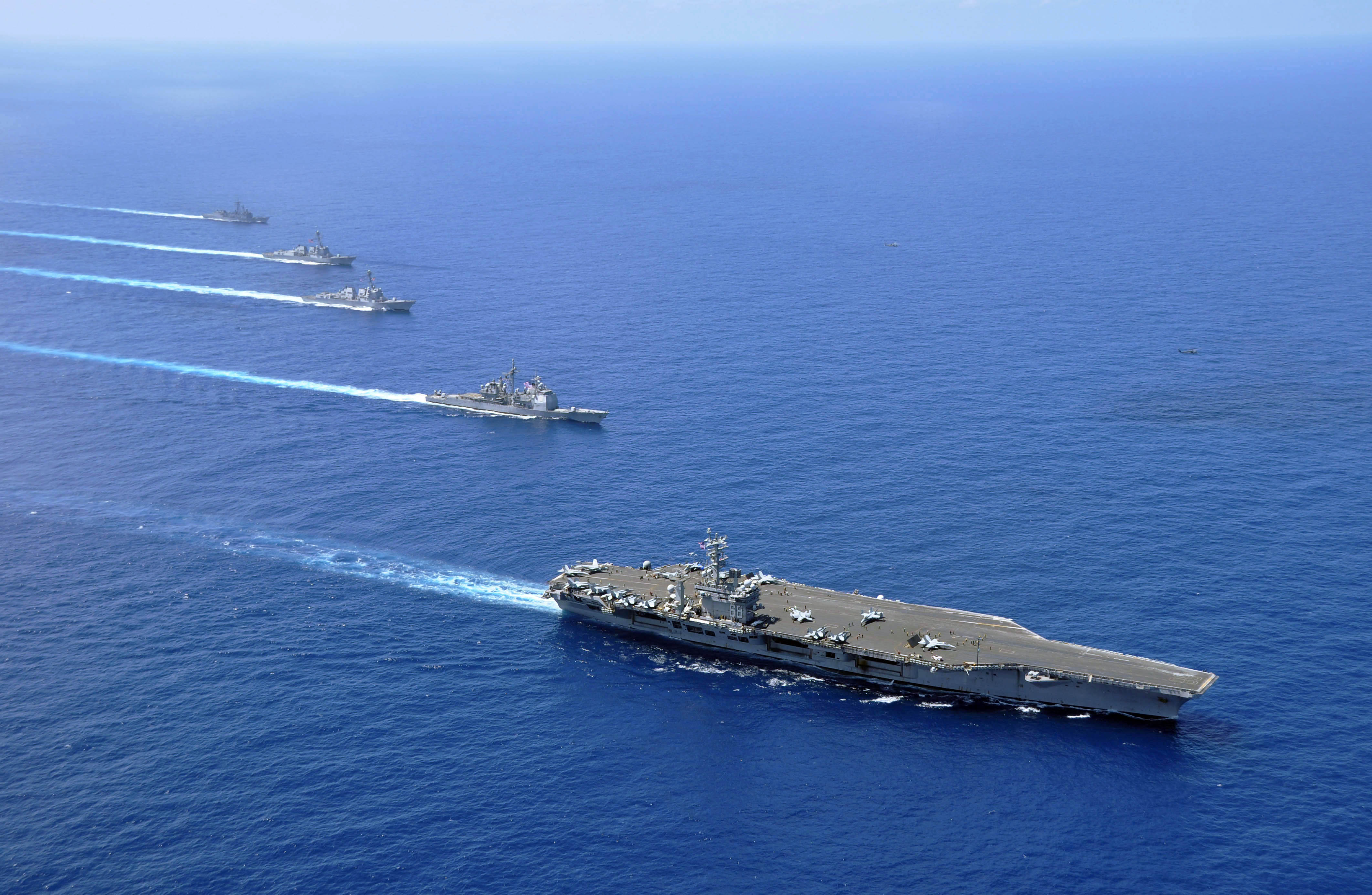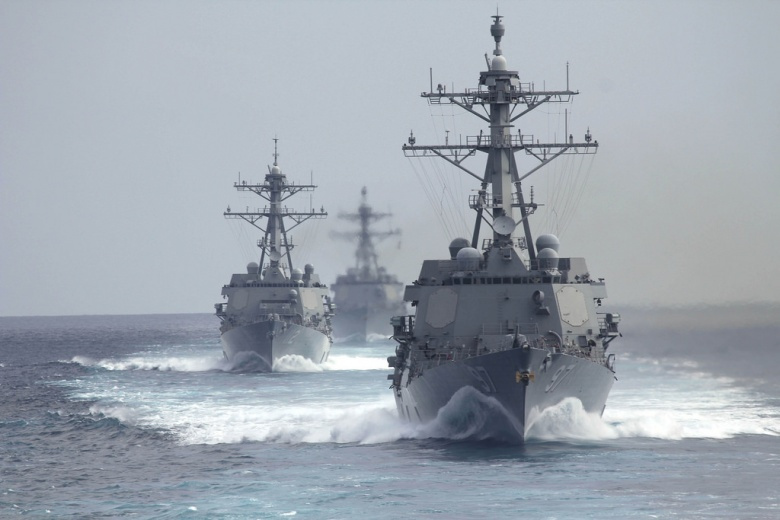

在中國南海北京方面仍“偏向虎山行”?
涉及到中國南海(SCS)最近發生的事件揭示中國思考在這一重要領域的海洋戰略。首先,中國認為,建立次區域霸權是可以實現的。其次,它有一個雙管齊下一個連貫的海洋戰略:現代化和重組其軍隊,以允許海軍力量投射,以及鞏固與東盟的外交和經濟關係。重組軍隊正與中國的同步“一帶,一之路”,因為他們需要一個強大的藍水海軍,以保護中國的海外擴張海上利益的積極性。同時,強大的海軍與非對稱能力,可以減輕美國的軍事技術優勢,保持在來自中國的南海領土擴張的距離。
中國正在進行七項它佔據了南海中珊瑚礁的填海工程:火熱的十字架,Cuarteron,Gaven,約翰遜南,McKennan惡作劇和渚碧礁。根據聯合國公約海洋法(UNCLOS),這些都是“低潮高地”不值得十二海裡領海區域。中國正建造完成軍事設施,特別是飛機跑道,在這三個島嶼,可以安裝雷達和防空導彈。這些人工島的潛力軍事化創造了期待中建立一個防空識別區(ADIZ)南海類似於中國東海在2013年11月,中國宣布一個地區許多人擔心的ADIZ將提供依據中國的空中控制南沙群島,並在該領域限制美國業務。根據情資研判中國極有可能在2016年夏季與蘇聯南海國際軍事演習結束後,公告中國南海防空識別區(ADIZ)?


這位學者雖然偏向美國在中國南海的戰略利益,卻也表達出美國在中國南海戰略的失誤?
(美國截至目前為止並未簽署聯合國海洋公約法),所以可以自由航行於世界上任何海洋,尤其甚者就是中國南海,這也就是說明美國在太平洋,大西洋,印度洋,北極海域,佈署眾多船艦及潛艦的理由之一,如今中國海軍強勢崛起,美國懼怕中國佔據國際間的重要戰略要地,尤其是海洋戰略據點,2013年的東海釣魚台列島事件,美國澈底輸掉,導致中國日後突破第一導鏈的封鎖線.
這也就是為什麼自2015年,美國不斷的派遣軍艦,飛機,潛艦至中國南海騷擾,中國在南海諸島的建設開發事業,如今中國在南海諸島的軍事佈署已經完成70%左右,除非美國以航空母艦戰鬥群為主,率先向中國開戰,並威脅其周邊越南,菲律賓,馬來西亞,印尼,日本等支援參戰,補給戰略物資,否則美國絕無勝算,因為美國自從越戰兵代敗,退出中南半島,並撤除菲律賓的海軍及空軍基地,說穿喇就是美國無意留守南海地區,從戰略觀點研判美國的重返亞太戰略計劃,只是紙上談兵的圍堵中國,騷擾中國在南海的事件,否則爭取不到龐大的國防預算,讓美軍在中國南海消費支出?

2015年11月25日,中國大皇帝習近平宣布人民解放軍的改革,將旨在實現一體化聯合作戰,克服嚴重的弱點在其能力在與美國並駕齊驅,使他們。解放軍海軍的戰略力量,其海軍力量的中國的預測作為治國方略的強制性工具的目的是行使對南海的控制。中國正在組裝優勢的海軍力量支持通過外交影響力與東盟阻止美國的干預。中國的雙管齊下,將變得越來越困難了美國削弱或“阻止”。其實這位學者藉由此偏文章是在暗示美國明知山有虎偏向虎山行而不是中國對不對?

Beijing Remains ‘Undeterred’ in the South China Sea.
Recent events related to the South China Sea (SCS) reveal Chinese thinking about its maritime strategy in that important area. First, China believes that establishing sub-regional hegemony is achievable. Second, it has a coherent maritime strategy with a two-pronged approach: modernizing and restructuring its military to allow for naval power projection, along with consolidating diplomatic and economic relations with ASEAN. Restructuring the military is in sync with China’s “One Belt, One Road” initiative as they require a strong blue-water navy to protect China’s expanding overseas maritime interests. Simultaneously, a strong navy with asymmetrical capabilities can mitigate U.S. military technological advantages, keeping it at a distance from China’s territorial expansion in the SCS.

China is conducting reclamation work on seven of the reefs it occupies: Fiery Cross, Cuarteron, Gaven, Johnson South, McKennan, Mischief and Subi Reef. Under the UN Convention on Law of the Sea (UNCLOS), these are “low-tide elevations” that don’t warrant a twelve-mile territorial zone. China is building military facilities, in particular airstrips, on three of these islands and can install radars and air defense missiles. The potential militarization of these artificial islands has created anticipation in the region of the creation of an Air Defense Identification Zone (ADIZ) in the SCS similar to the one declared by China in the East China Sea in November 2013. Many fear an ADIZ would provide the basis for China’s air control over the Spratly Islands and could constrain U.S. operations in that area.

China has pursued maritime assertiveness at the expense of its weak neighbors. The expansive Chinese claims enclosed by the U-shaped arc impinge upon the rights of Vietnam, the Philippines, Taiwan, Malaysia and Brunei to exploit waters within two hundred nautical miles of their respective EEZs as granted under UNCLOS. If left unchallenged, Philippines and Malaysia will lose about 80 percent of their EEZ, Vietnam about 50 percent, Brunei about 90 percent, and Indonesia about 30 percent.
The second prong of China’s strategy is to offset any collective negative response by ASEAN, a potential threat since four of its members – Brunei, Malaysia, Philippines, and Vietnam – have disputes with China over the SCS. China’s strategy is based on embedding the ASEAN interest in an extensive weave of economic and defense relations and insisting that dispute settlement should be done on a bilateral basis.

To strengthen relations with ASEAN, on Oct. 16, 2015, China held the inaugural ASEAN-China Defense Ministers’ Informal Meeting (ACDMIM) in Beijing where it proposed to hold joint training on the Code for Unalerted Encounters at Sea (CUES) and to set up an “Asian” dispute settlement mechanism without the interference of outside powers.
Malaysia, despite its dispute with China, has been its largest ASEAN trading partner since 2008, and is also China’s third biggest Asian trading partner after Japan and South Korea. In 2013, the first joint Malay-Sino industrial park was launched and will be completed by 2020 and both have pledged to increase bilateral trade to $160 billion by 2017. The Philippines, similarly, has no qualms about expanding relations with China, and joined China’s “Maritime Silk Road” program announced by President Xi in 2013. It also decided to join the China-led Asian Infrastructure Investment Bank (AIIB) and signed AIIB’s Articles of Agreement before the end of 2015.
These efforts appear to have paid off. ASEAN has twice refrained from issuing a declaration that mentions Beijing’s assertiveness in the SCS: first at the July 2012 ASEAN Summit in Cambodia and then at the 3rd biannual ASEAN Defense Ministers Plus (ADMM-Plus) meeting in Kuala Lumpur on Nov. 4, 2015. China has been able to counter the increasing US influence in ASEAN.
China remains “undeterred” despite the much publicized dispatch of the guided-missile destroyer USS Lassen in October 2015 to the SCS, on a Freedom of Navigation Operation (FONOP) as a “challenge” to China’s expansion of territorial claims. The sailing of the US destroyer within 12 nautical miles of Subi Reef, an artificial island, was neither a “deterrent” nor a “challenge” but an “innocent passage” under Article 17 of UNCLOS, a right granted to all ships, enabling transit in another state’s territorial waters without permission. Two Chinese surface warships (the destroyer Lanzhou and the frigate Taizhou) kept a close tail on the destroyer, checking for activities that might be prejudicial to China or prohibitive under Article 19 of UNCLOS. However, the Lassen conducted a continual smooth passage throughout the contested waters.
Some have asserted that by conforming to rules of the “innocent passage,” the US might have inadvertently recognized China’s territorial sovereignty. Indeed, there are assertions that this proves the US is being deterred, as does the flight of two US B-52 nuclear bombers in the area of the Spratly Islands, within two nautical miles of Cuarteron Reef on Dec. 10. Initially, media reports claimed that it was a routine mission in international air space but Pentagon spokesman Commander Bill Urban later clarified that there was no intention of flying within 12 nautical miles and that it was not a FONOP. He explained that the bomber had accidentally strayed as a result of bad weather into the airspace of the artificial island built by China. There is evidently a mismatch between heightened rhetoric calling for undeterred US FONOPs and expected payoffs, unless the objective was to measure China’s resolve, preparedness, and competence in handling a breach in waters and air-space claimed by it.
Meanwhile, China continues to develop its maritime capabilities. On May 13, 2015, Justice Antonio T. Carpio, senior associate justice of the Supreme Court of the Philippines, assessed China’s naval buildup in a presentation at the International Institute of Social Studies in The Hague. He noted that China is building supply ships like Type 904A with a helipad and storage for one Z-8 heavy transport helicopter to service outposts in the Paracels and the Spratlys. China’s Coast Guard is the largest blue-water coast guard fleet in the world, larger than that of Japan, Vietnam, Indonesia, Malaysia, and the Philippines combined. And Beijing plans to deploy a 10,000-ton coast guard and a 40 Type 056 Corvette fleet. In 2014, China had 15 Type 054 frigates and plans to produce 40 of the newer Type 056 frigates.
On Nov. 25, 2015, President Xi Jinping announced a restructuring of the PLA that would aim to achieve integrated joint operations and overcome serious weaknesses in its capabilities to bring them at par with the US. The strategic force of the PLA Navy and China’s projection of its naval power as a coercive instrument of statecraft are designed to exercise control over the SCS. China is assembling a preponderant naval power backed by diplomatic clout with ASEAN to deter US intervention. China’s two-pronged approach will become increasingly difficult for the U.S. to dent or “deter.”
